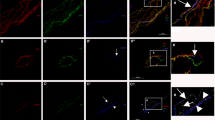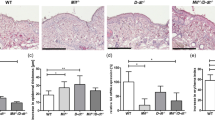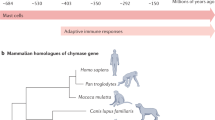Abstract
A CURIOUS feature of carcinogenesis in the skin of the mouse is the intense mast-cell reaction which gradually develops in the dermis immediately under the painted hyperplastic epidermis. Cramer and Simpson1 observed that some of these new mast cells exhibit a golden-brown fluorescence in ultraviolet light, providing that the frozen section has also been treated with formaldehyde.
This is a preview of subscription content, access via your institution
Access options
Subscribe to this journal
Receive 51 print issues and online access
$199.00 per year
only $3.90 per issue
Buy this article
- Purchase on Springer Link
- Instant access to full article PDF
Prices may be subject to local taxes which are calculated during checkout
Similar content being viewed by others
References
Cramer, W., and Simpson, W. L., Cancer Res., 4, 601 (1944).
Riley, J. F., and West, G. B., J. Physiol. (Lond.), 120, 528 (1953).
Benditt, E. P., Wong, R. L., Arase, M., and Roeper, E., Proc. Soc. Exp. Biol. (N.Y.), 90, 303 (1955).
Riley, J. F., Experientia, 13, 141 (1958).
Gomori, G., “Microscopic Histochemistry”, 128 (Univ. Chicago Press, 1952).
Pearse, A. G. E., “Histochemistry—Theoretical and Applied”, second edit., 925 (Churchill, 1960).
Author information
Authors and Affiliations
Rights and permissions
About this article
Cite this article
COUPLAND, R., RILEY, J. Mast Cells and 5-Hydroxytryptamine in Precancerous Mouse Skin. Nature 187, 1128–1129 (1960). https://doi.org/10.1038/1871128a0
Issue Date:
DOI: https://doi.org/10.1038/1871128a0
This article is cited by
-
Indole reactions of mast cells and enterochromaffin cells related to fixations with and without aldehydes
Histochemistry (1978)
-
Reduction and azo coupling of quinones
Histochemistry (1977)
-
Mast cells in the skin of normal, hairless and athymic mice
Experientia (1976)
-
Some histochemical reactions of mast cells of gerbils, hogs, armadillos and cats
Histochemistry (1974)
-
Histochemical comparison of mast cell and globule leucocyte granules in the rat
Experientia (1967)
Comments
By submitting a comment you agree to abide by our Terms and Community Guidelines. If you find something abusive or that does not comply with our terms or guidelines please flag it as inappropriate.



